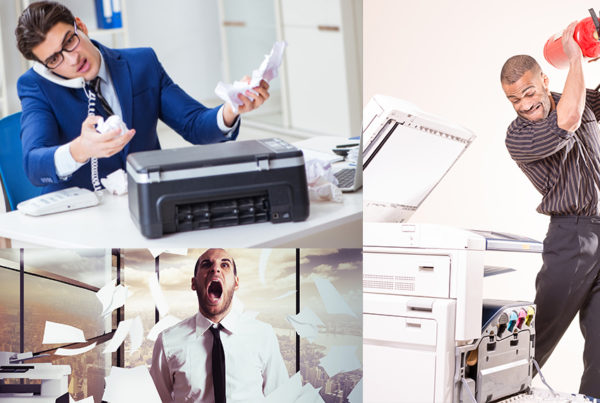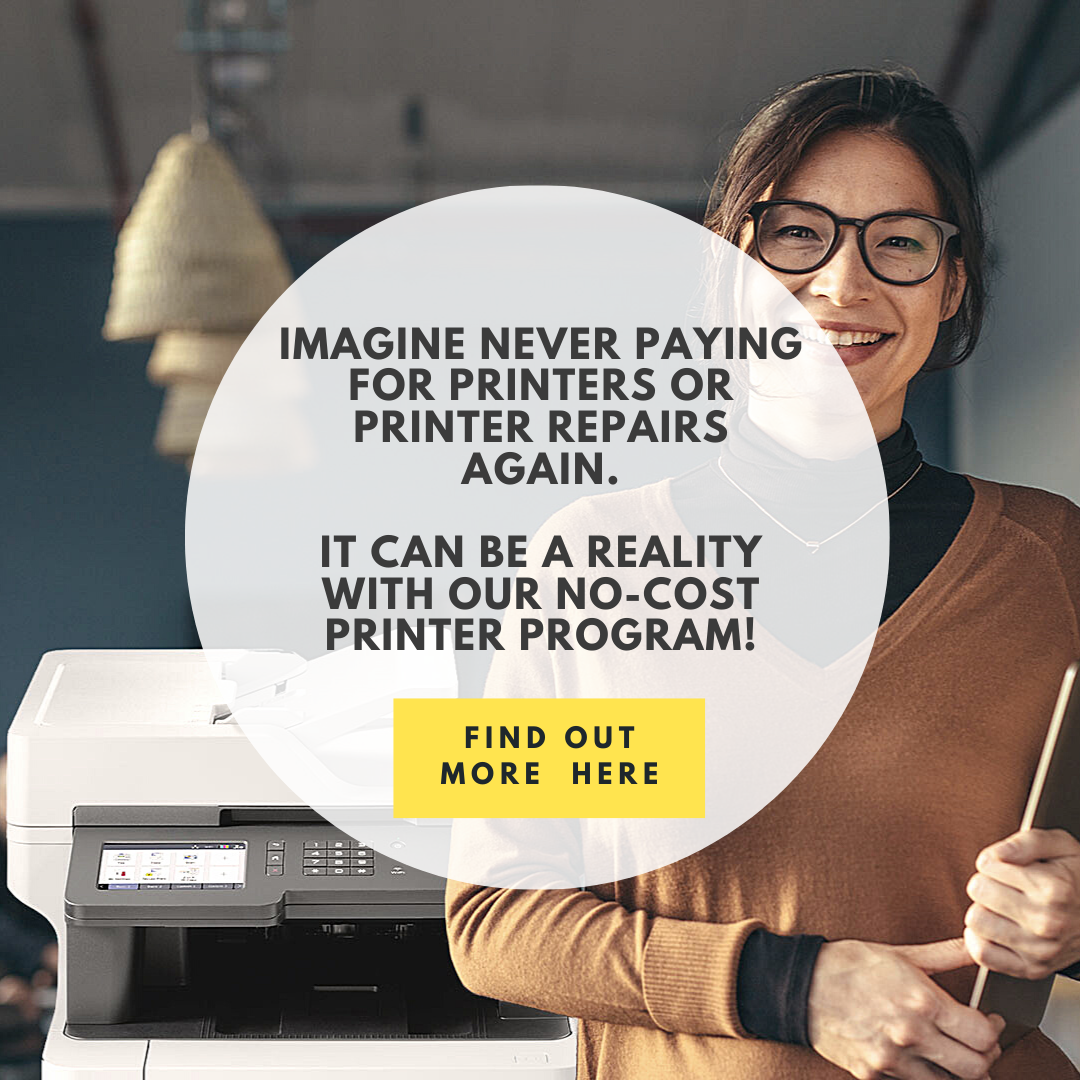There is that saying of good intentions leading one to a bad place. It makes sense in the workforce when you think about it. We all want what’s best for our business or home office environment – but sometimes those good intentions are saddled with bad habits, false assumptions, and a steady diet of keeping up with the Joneses.
Buying a printer is a perfect example.
Unknowingly, you might be committing wicked mistakes when either purchasing one printer or upgrading a printer fleet. The result is a potentially dysfunctional environment of needless printer repairs/service; smudged or late-delivered documents caused by printer breakdowns; and a considerable dent in the budget due to runaway printing costs.
Let’s look at the Seven Deadly Sins of buying a printer, which if overcome, you will know how to choose a printer that meets your needs, leading you to paradises of productivity and cost savings.
Pride
You’re holding on to aging or outdated printers, regardless of how many times coworkers complain about disruptive software updates or printer jams. You want to keep the course, even if your office is gaining employees or your home business is booming – requiring a shift in printing needs. Never mind the reality that printing quality has become poorer and the darn machine continually requires service.
Swallow your pride, understanding that the average lifespan of an inkjet is three years while a laser printer lasts about five years. There’s just a good chance it’s time to admit defeat, give your printers a Marie Kondo goodbye, and start a holy quest for the best possible printer(s).
If you need a further boost, consider that the EPA states that if your printing device is older than five years, its consumption is about 50% higher than a new device. What’s more, New Energy Star qualified printers are 40-55% more energy competent than standard models.
Sloth
You’ve committed to searching for a new printer, but why even bother knowing what your printing needs might be? You’ve got work to do and, uh, documents to print. So you need to know how to choose a printer now.
Without the right printer, you’ll never get the right productivity or cost-efficiency. Just Consider that three percent of a company’s revenue is spent on paper. Your brand can do better.
By understanding your monthly print volume, you’ll recognize the printer that works bests for your work environment. How do you do that? Look at historical paper purchases, perform a quick print assessment, or run a machine history report on your current printer.
How powerful should your printer be?
The larger your print volumes, the bigger the printer you need. The bigger the engine, the more “Pages-Per-Minute” that engine will produce. Here’s a quick guideline:
# Pages Printed Per Month Pages-Per-Minute (ppm)
Up to 1000: 10 – 15 ppm
1,000 – 2,000: 16 – 20 ppm
2,000 – 3,000: 21 – 30 ppm
3,000 – 5,000: 31 – 40 ppm
6,000 – 15,000: 41 – 50 ppm
15,000+: 51+
With a little research, you’ll be on your way to knowing your printing needs
Greed
The next step is to make sure you purchase a printer with all the bells and whistles, right? It should include:
• Print • Copy • Scan • Fax
• Extra Paper Trays • Network Enabled • Mobile Ready • 2 Sided or Duplexing
• Color or Black & White
Everything! And a 3D printer on the side, please!
Seriously, there’s no point in getting printer features if you’re never going to leverage them. Reflect on what you want out of a printer, besides it being dependable and productive, and then go forth and find. You’ll likely spend a lot less than you initially thought.
Keep this in mind when buying a printer or any imaging device: Only two percent of office printing is performed on ledger size paper (11 x 17 inches). Machines offering nonstandard paper size tend to be far costlier than those with a limited 8.5 x 11 trays.
Lust
Watch out, because desire is still around. In printing, the yearning for color is the strongest of desires.
But do you need a color printer? Color prints cost 5 – 10 times more than a page printed in black and white. If you’re in the legal or accounting field, perhaps a dependable laser printer with monochrome toner will satisfy all your business longings.
Also, black and white prints only require one cartridge while color printers require four different toners that are combined to produce an image. Black and white printers have fewer supplies to manage, fewer issues, and can just save you a lot of money.
But if you do require a color printer, make sure you understand the following deadly sin…
Gluttony
If you don’t have one yet, it’s a very good idea to implement a print policy before any new printers arrive. Why? Ninety-percent of offices have no formal print policy in place, while two-thirds don’t tracktheir printing expenses. When paired with the reality that the average office worker prints 10,000 pages per year at the cost of about $725. In short, there’s a high chance that right now any business is gripped by a paper and ink bacchanalian. (And that includes wasteful (and lustful) use of color printing.)
Here some initiatives you can include in your print policy:
- Reusing printed paper and enforcing paper-less meetings
- Restricting color printing
- Printing on two sides of a page for in-house docs
- Print managed services that maintain printers and track every doc printed – demonstrated to reduce business costs by 20-30%
Envy
Sometimes envy is known as Fear of Missing Out (FOMO), and it’s widely exploitable by big brands and managed print providers. They will tell you that “everyone else” is employing large, bulky imaging devices. “You can have one too,” they’ll whisper in your ear, “if you just lease one of our machines.” What happens after you sign their long-term contract is that you’ll be locked into buying their expensive printer brand toner cartridges that cost up to 30% more than alternatives.
Don’t bite into this FOMO forbidden apple. By selecting a printer that can use premium-quality, toner-alternative cartridges, you will still be able to get the image quality at a fraction of the price.
We, of course, like to offer our no-cost printer programs, which gives you the flexibility for the right printer solutions without being locked down.
Wrath
Yes, you’ve learned how to choose a printer! Champagne is out, and the sound of high-fives fills the office (or at least your head).
Now it’s time to bring fire and brimstone upon your old printer that dared hinder your productivity, money, and patience. You sneer at your printer and say with your best English-villain accent, “Off you go to the dumpster or the dark inventory closet where you’ll be forgotten by the universe.”
As Yoda would say as if he saw you consumed by the printer Dark Side: “Fast, not so!”
To really exorcize all your deadly sins, the best option is to recycle your old printer. You don’t want your printer to join the more than 375 million empty ink and toner cartridges in landfills each year.
Here are several options to recycle printers:
Students Recycling Used Technology
Alternatively, Googling “E-Waste Collection Near Me” will lead to many recycling centers around you that will gladly take your old printer.
If you’re wondering about ink and toner cartridges, beyond recycling, a printing policy and managed print services will help you go greener – since you’re no longer a slave to gluttony – as well as considering remanufactured cartridges instead of big brand ones.
You’ve saved your business or home office’s soul, as well as helped planet earth. Life is good. Enjoy that champagne. Now you know the seven deadly sins and how to choose a printer.







